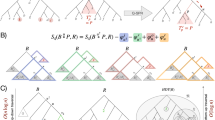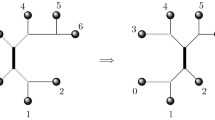Abstract
We present a new technique called balanced randomized tree splitting. It is useful in constructing unknown trees recursively. By applying it we obtain two new results on efficient construction of evolutionary trees: a new upper time-bound on the problem of constructing an evolutionary tree from experiments, and a relatively fast approximation algorithm for the maximum agreement subtree problem for binary trees for which the maximum number of leaves in an optimal solution is large. We also present new lower bounds for the problem of constructing an evolutionary tree from experiments and for the problem of constructing a tree from an ultrametric distance matrix.
Access this chapter
Tax calculation will be finalised at checkout
Purchases are for personal use only
Preview
Unable to display preview. Download preview PDF.
Similar content being viewed by others
References
J. C. Culbertson and P. Rudnicki. A fast algorithm for constructing trees from distance matrices. Information Processing Letters, 30(4):215–220, 1989.
M. Farach, S. Kannan, and T. J. Warnow. A robust model for finding optimal evolutionary trees. Algorithmica, 13(1/2):155–179, 1995.
M. Farach, T. M. Przytycka, and M. Thorup. Computing the agreement of trees with bounded degrees. In P. Spirakis, editor, Lecture Notes in Computer Science 979: Proceedings of the Third Annual European Symposium on Algorithms, pages 381–393. Springer-Verlag, New York, NY, 1995.
M. Farach and M. Thorup. Fast comparison of evolutionary trees (extended abstract). In Proceedings of the 5th Annual ACM-SIAM Symposium on Discrete Algorithms, pages 481–488, 1994.
C. R. Finden and A. D. Gordon. Obtaining common pruned trees. Journal of Classification, 2:255–276, 1985.
L. Gasieniec, J. Jansson, A. Lingas, and A. Östlin. On the complexity of computing evolutionary trees. In Lecture Notes in Computer Science 1276: Proceedings of the 3rd Annual International Computing and Combinatorics Conference, pages 134–145, 1997.
M. R. Henzinger, V. King, and T. J. Warnow. Constructing a tree from homeomorphic subtrees, with applications to computational biology. In Proceedings of the 7th Annual ACM-SIAM Symposium on Discrete Algorithms, pages 333–340, 1996.
S. K. Kannan, E. L. Lawler, and T. J. Warnow. Determining the evolutionary tree using experiments. Journal of Algorithms, 21:26–50, 1996.
M. Y. Kao. Tree contractions and evolutionary trees. SIAM Journal on Computing, 1998. To appear.
M. Y. Kao, T. W. Lam, T. M. Przytycka, W. K. Sung, and H. F. Ting. General techniques for comparing unrooted evolutionary trees. In Proceedings of the 29th Annual ACM Symposium on Theory of Computing, pages 54–65, 1997.
D. Keselman and A. Amir. Maximum agreement subtree in a set of evolutionary trees-metrics and efficient algorithms. In Proceedings of the 35th Annual IEEE Symposium on the Foundations of Computer Science, pages 758–769, 1994. To appear in SIAM Journal on Computing.
C. Phillips and T. J. Warnow. The asymmetric median tree-a new model for building consensus trees. In Proceedings of the 7th Annual Symposium on Combinatorial Pattern Matching, pages 234–252, 1996.
M. Steel and T. J. Warnow. Kaikoura tree theorems: Computing the maximum agreement subtree. Information Processing Letters, 48:77–82, 1993.
Author information
Authors and Affiliations
Editor information
Editors and Affiliations
Rights and permissions
Copyright information
© 1999 Springer-Verlag Berlin Heidelberg
About this paper
Cite this paper
Kao, MY., Lingas, A., Östlin, A. (1999). Balanced Randomized Tree Splitting with Applications to Evolutionary Tree Constructions. In: Meinel, C., Tison, S. (eds) STACS 99. STACS 1999. Lecture Notes in Computer Science, vol 1563. Springer, Berlin, Heidelberg. https://doi.org/10.1007/3-540-49116-3_17
Download citation
DOI: https://doi.org/10.1007/3-540-49116-3_17
Published:
Publisher Name: Springer, Berlin, Heidelberg
Print ISBN: 978-3-540-65691-3
Online ISBN: 978-3-540-49116-3
eBook Packages: Springer Book Archive




